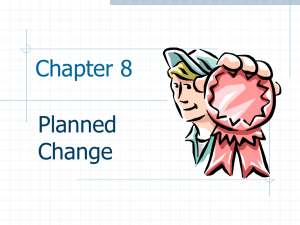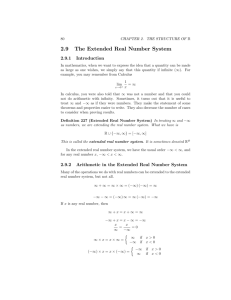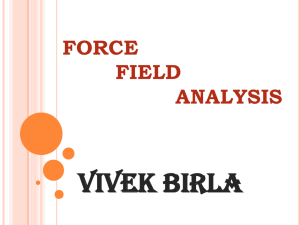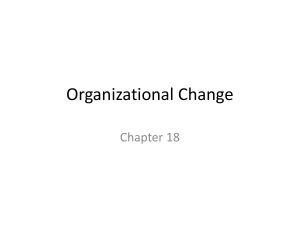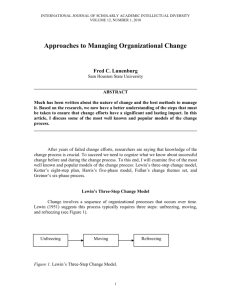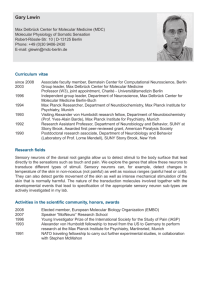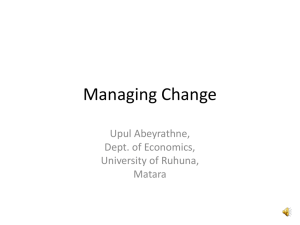Change and the Management of change
advertisement
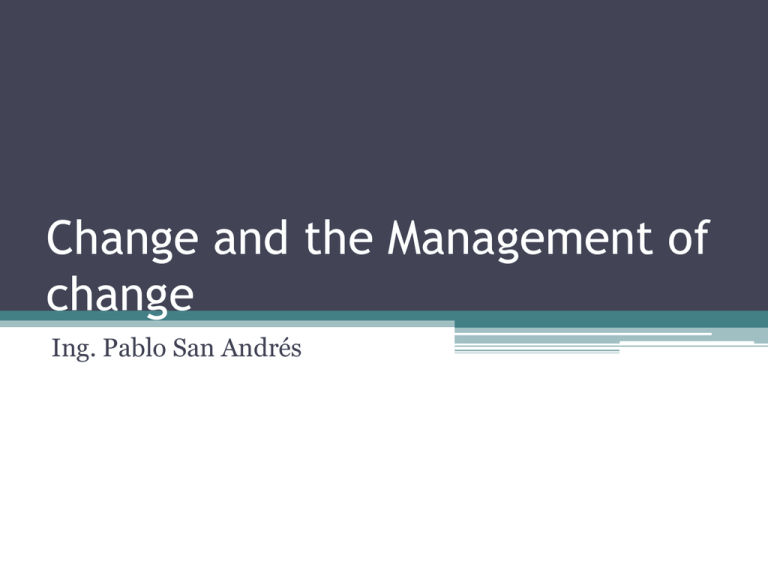
Change and the Management of change Ing. Pablo San Andrés Introduction • Globalization and e commerce, for example, have meant that multinationals have had to adapt in order to survive. • One of the most difficult tasks for any manager is to manage the change process • Change Management refers to processes and techniques used to plan, implement and evaluate changes in business operations in order to achieve a required objective. Introduction Change may include: • New product development • A change in organizational structure • New policies • New targets • New mergers and acquisitions • Relocations • Pay deals Introduction Change may cause problems because people can be resistant to change For example: Motor vehicle manufacturers, for example, have been forced into being conscious of environmental challenges. Toyota’s Earth Charter, for instance, was set up back in 1992. It launched the Toyota Prius, the world’s first mass produced gas-electric hybrid, in Japan back in 1997. http://www.youtube.com/watch?v=EqNVEG-dIvM Factors causing change There are six main factors that will influence change: Customers • They demand better quality products at competitive prices. • This presents challenges for any business. • Customers may also change their habits and tastes. Factors causing change Competitors • They will try to provide better services and products, perhaps through new product development and other marketing strategies. • Growth of rivals firms through mergers and acquisitions will also present threats to a business. Factors causing change Management It will need to stay abreast of market trends to ensure that the business remains competitive. Factors causing change Technological progress Such as the microchip revolution, communications technology, the internet and ecommerce have forced firms to change the way they conduct their business. Factors causing change Government Changes in legislation can have a profound impact on businesses. Ex: Partygames, the world’s largest online gaming businesses, was baldly affected by new legislation in the USA in late 2006 when the government made online gaming illegal. Ex: In Ecuador, casinos were closed by the Government of Rafael Correa. http://www.youtube.com/watch?v=YYMGJtYnLWk Factors causing change External factors • Changes in fashion • The state of the economy (such as a recession) • Globalization will create change in an organization. • Terrorist attacks Resistance to change One of the major barriers to effective change management is the resistance to change from the workforce. 1) Self-interest: Some people feel that any change involves extra effort Resistance to change 2) Misunderstanting Staff often feel that change is not necessary as things are going well Resistance to change Different assessments of the situation It occurs when management and staff disagree on the advantages and disadvantages of change. For example: Managers may feel that restructuring of the workforce is necessary, but workers may think is a waste of time (They are the experts in the roles that they fulfil) Resistance to change Low tolerance of change • People prefer familiarity rather than disruptions and uncertainties. • They are scared of being made redundant Six Change Approaches Kotter proposed six change approaches model to deal with resistance to change. 1.- Education and Communication This approach aims to inform and educate staff (and other stakeholders) about the change beforehand in other to establish a degree of trust (It avoids rumours) Six Change Approaches 2.- Participation and Involvement This approach links with several motivational theorists who argue that employee involvement in decision-making can motivate and improve morale amongst the workforce. Six Change Approaches 3.- Facilitation and Support Managerial support can be in numerous forms, such as counselling employees to deal with their fears and apprehensions or the retraining of staff to enable to accommodate the new changes. Six Change Approaches 4.- Negotiation and Agreement Managers use incentives to remove or limit any resistance to change. For example: Accept amendments in their employment contracts to accommodate the new changes. Six Change Approaches 5.- Manipulation and Co-option This approach involves bringing a representative of those resisting change into the change process. In that way, he can communicate the advantages to others. Six Change Approaches 6.- Explicit and Implicit Coercion Managers can use coercion (bullying tactics) to force staff into accepting change, by threating disciplinary action, dismissals, job losses, redeployment (transferring employees to other jobs), or not promoting employees. Don’t forget Make employees love their job https://www.youtube.com/watch?v=DiNO85sanm4 Planning change Change could only be pursued if there is a clear set of goals. There are 2 types of forces: 1) Driving forces.- Push for change 2) Restraining force.- Act against proposal change Planning change Planning change Planning change Before instigating any organizational change, managers musk ask themselves 1) Why is change needed? 2) What do we hope to achieve with such change? 3) Who is affected by this change and how are they likely to react to the change? 4) How will we know that the change has been successfully achieved? Planning change One method to aid managers facing change is Force Field analysis. It is useful for managers because in that way, they can then plan to strengthen the forces supporting a decision change, and reduce the impacts of opposition to it. Lewin’s Force Field Analysis 1. List the encouraging forces for change and the burdening forces against change. 2. Allocate a weight to each of these forces, from 1 (weak) to 5 (strong). 3. Draw a diagram showing the forces for and against change. 4. Show the relative effect of each force by a number next to it. Lewin’s Force Field Analysis Lewin’s Force Field Analysis Advantages • If a manager has already decided on this option, force field analysis can help to work out to improve a project’s changes of success. • Managers can investigate how the driving forces can be strengthened and how the restraining forces can be reduced or eliminated. • Small adjustment to the forces can result in many small changes and improvements Lewin’s Force Field Analysis Disadvantages • Weightings attached to the forces may be subjective rather than referring to facts or evidence. • Not all relevant forces may be considered (Overemphasize the need for change) Lewin’s Force Field Analysis Force Field Analysis is a useful technique of weighting advantages and disadvantages to help decide whether any proposed change is worth implementing. Change management and models and frameworks There are four steps to any management model 1) Identify the proposed change and the rationale for change. 2) Brainstorm the driving forces and the restraining forces of the change 3) Develop and communicate an understanding of these issues to key stakeholders 4) Implement actions to take advantage of driving forces and to overcome the restraining forces In addition Lewin’s force analysis and Kotter’s Six change Approaches models, there are other change management models Change Management Models and Frameworks Iceberg Model Wilfried Kruger’s Iceberg model of change argues that there are two levels of change but that managers often only concentrate their efforts on the top level of the iceberg Top level: Cost, Quality and Time. Bottom level: People: Attitudes, beliefs, perceptions, acceptance and behaviour of stakeholders (which can be negative of positive) Change Management Models and Frameworks Change Management Models and Framework Kruger suggests that there are several groups of people who may hinder or enhance the change process. Opponents: Have a negative attitude towards change Promoters: Have a positive attitude towards change. They therefore support the change as they feel that they will personally benefit from it. Hidden opponents: Negative attitude towards change, but seem to accept change in a superficial way, perhaps to avoid conflict or getting into trouble. Potential promoters: Positive attitude towards change, but they are not yet fully convinced about the particular change in questions Change Management Models and Framework What is the solution? Incentives or coercion for the opponents and consultation with the hidden opponents Change Management Models and Framework Change Phases model Proffesor J.P. Kotter’s Change Phases model (1990) suggests that there are eight reasons why change management might fail. His reasons are because manager: • Allow too much complexity • Fail to win support from staff • Do not have a clear vision • Fail to communicate the vision to stakeholders • Allow obstructions to the vision Change Management Models and Framework • Do not focus on small continuous changes (to win support). • Declare success too soon. • Ignore corporate culture when implementing change. Ex: A company decides to implement a curse of meditation for employees, but some of them can’t be there because of religion. If the boss doesn’t respect that, it means that respect value is not paying attention. Change Management Models and Framework Change must be specific, measurable, achievable, realistic. Ex: To increase the sales by 10% the following year. Change masters • Successful managers must be able to react quickly to changes in the external environment. • To control any change effectively, managers need certain qualities or skills. _ To provide a clear vision statement _ Communication skills _ Tolerance _ Managers should encourage team spirit _Listening and inquiry skills _Financial resources to be able to implement the change Storey´s Change model There are 4 approaches to manage the change process in an organization 1) Total imposed package: This appoach entails delevering a package of change to employees as an executive decision by managment without any process of negotiation or consultation. Storey´s Change model 2) Imposed piecemeal initiative: It is not as extreme as the total imposed package but change is still imposed on the employees; only in stages rather than all in one go. • It allows workers more time to adapt to change • Examples of such an approach include offering financial and non-financial incentives for the successful implementation of change. Storey´s Change model 3) Negotiated total packages: This approach is the opposite of method 1, as the aim is to seek a package of change via negotiation with the staff. Advantage: Employees are more likely to push for change and resistance to change is minimized Storey’s Change model 4) Negotiated piecemeal packages: This approach sees a gradual implementation of change through a series of negotiations with the workforce. Stakeholder analysis It is used to identify which stakeholders need to be involved in the change process by looking at their level of influence and their reaction to change.
